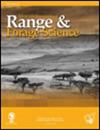色堇变种马卡里kariense颖果保留的遗传分析
IF 1.9
4区 环境科学与生态学
Q3 ECOLOGY
引用次数: 0
摘要
色堇是一种原产于南非的C4型草。在阿根廷,它因在资源有限的环境中生产优质牧草而受到重视,尽管它很少在牲畜系统中种植。本研究的目的是利用子代-亲本回归法估计颖果性状的狭义遗传力(h 2),并利用issr型标记表征颖果性状的分子多样性。唯一显著值是在第5周,这表明加性遗传变异的存在及其稳定性。ISSR标记可以通过条带和每个基因型的独特等位基因确认品种之间和同一品种个体内存在遗传变异。Kapivera品种的个体已经能够通过检测区分两个品种的位点和等位基因在遗传上与Bambatsi品种的个体区分开来。事实证明,这些标记对所分析的品种的区分是有效的,并且在品种中观察到广泛的变异。对彩竹变种马卡里kariense的遗传多样性进行鉴定是将其纳入该物种育种计划的基础步骤。本文章由计算机程序翻译,如有差异,请以英文原文为准。
Genetic analysis of Panicum coloratum var. makarikariense caryopsis retention
Panicum coloratum is a species of C4 type grass native to South Africa. In Argentina, it is valued for its production of good quality forage in environments where resources are limiting, although it is infrequently cultivated in livestock systems. The purpose of this study was to estimate the narrow sense heritability (h 2) of the caryopses fall character using the Progeny-Parent Regression method and characterise molecular diversity using ISSR-type markers. The only significant value obtained was in week five, which gives an indication of the existence of additive genetic variance and also its stability. The ISSR markers allowed confirming the existence of genetic variability between cultivars and within individuals of the same cultivar through bands and unique alleles per genotype. The individuals of the Kapivera cultivar have been able to genetically differentiate themselves from the individuals of the Bambatsi cultivar by detecting loci and alleles that differentiate both cultivars. These markers proved to be effective for the distinction of the cultivars analysed and a wide variability has been observed in the species. The characterisation of the genetic diversity within the cultivars of P. coloratum var. makarikariense constitutes a fundamental step for its potential incorporation into breeding programs developed in the species.
求助全文
通过发布文献求助,成功后即可免费获取论文全文。
去求助
来源期刊

African Journal of Range & Forage Science
ECOLOGY-ENVIRONMENTAL SCIENCES
CiteScore
4.00
自引率
14.30%
发文量
35
审稿时长
>12 weeks
期刊介绍:
The African Journal of Range & Forage Science is the leading rangeland and pastoral journal in Africa. The Journal is dedicated to publishing quality original material that advances rangeland ecology and pasture management. The journal aims to publish research of international importance from any region, but as an African journal, we are particularly interested in research from Africa and relevant to the continent. The Journal promotes both science and its application and authors are encouraged to explicitly identify the practical implications of their work. Peer-reviewed research papers and research notes deal primarily with all aspects of rangeland and pasture ecology and management, including the ecophysiology and biogeochemistry of rangelands and pastures, terrestrial plant–herbivore interactions (both domestic and wild), rangeland assessment and monitoring, effects of climate change on rangelands, rangeland and pasture management, rangeland rehabilitation, ecosystem services in support of production, conservation and biodiversity goals, and the identification and development of intensive and semi-intensive pasture and forage resources to meet livestock production needs. Articles highlighting transdisciplinary linkages among biophysical and social sciences that support management, policy and societal values are particularly encouraged. The Journal includes relevant book reviews and invited perspectives that contribute to the development of range and forage science. Letters to the editor that debate issues raised in the Journal are acceptable. The African Journal of Range & Forage Science is the official journal of the Grassland Society of Southern Africa.
 求助内容:
求助内容: 应助结果提醒方式:
应助结果提醒方式:


